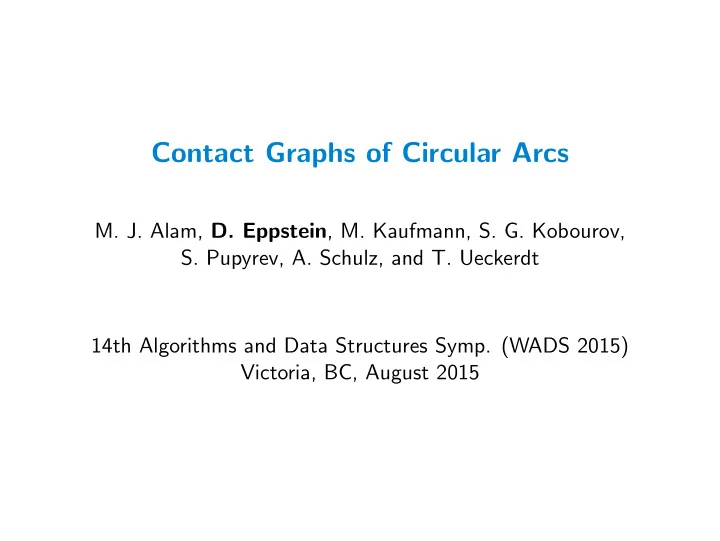

Contact Graphs of Circular Arcs M. J. Alam, D. Eppstein , M. Kaufmann, S. G. Kobourov, S. Pupyrev, A. Schulz, and T. Ueckerdt 14th Algorithms and Data Structures Symp. (WADS 2015) Victoria, BC, August 2015
Intersection graphs vs contact graphs Intersection graph: Contact graph: ◮ Vertices: geometric objects ◮ Objects cannot overlap ◮ Edges: overlapping pairs ◮ Edges: touching pairs
Examples of contact graphs: disks Koebe–Andreev–Thurston circle packing theorem: The contact graphs of disks are exactly the planar graphs Many applications in graph theory, graph drawing, mesh generation, neuroanatomy, etc.
Another example: Axis-aligned segments Each contact has one endpoint and one interior point Realizable graphs are exactly the planar bipartite graphs Hartman, Newman, and Ziv, “On grid intersection graphs”, Disc. Math. 1991
Another example: Non-aligned segments Each subset of k segments has ≥ 3 non-contact endpoints at the vertices of its convex hull, 2 k − 3 remaining potential contacts Realizable graphs are exactly the planar graphs in which every k vertices induce a subgraph with at most 2 k − 3 edges Alam et al., “Proportional contact representations of planar graphs”, JGAA 2012
Our question: What about circular arcs? Only allow endpoint-interior contacts (else same as circle packings) May not have any endpoint non-contacts on convex hull Pairs of arcs may have multiple contacts ⇒ multigraphs
Sparse and tight graphs ( a , b )-sparse: each k -vertex subgraph has ≤ ak − b edges ( a , b )-tight: ( a , b )-sparse and whole graph has exactly an − b edges For planar graphs: ◮ (2 , 3)-tight = Laman (minimally rigid) ◮ (2 , 3)-sparse = contact graph of line segments (2, 3)-tight ◮ (2 , 4)-tight = maximal bipartite ◮ (2 , 4)-sparse = (2, 4)-tight triangle-free ◮ For a ∈ { 2 , 3 , 4 } , (2, 4)-sparse dual of (2 , a )-tight is always (2 , 4 − a )-tight
Henneberg moves All (2 , 2)-tight and dual-(2 , 3)-tight graphs can be constructed by sequences of three moves, starting from simple base cases: Each move can be performed in any circular arc representation (Proof: messy case analysis) Corollary: All such graphs can be represented by circular arcs
Arc representations from circle packings Break circles into arcs turning tangencies into arc contacts Extra property: each arc has empty convex hull This method works ⇐ ⇒ graph has an edge orientation with ◮ Outdegree ≤ 2 ◮ When outdegree = 2, both out-edges are adjacent Which graphs have such orientations?
4-regular graphs have good orientations Group opposite pairs of edges at each vertex into curves, orient each curve consistently
Orienting (2, 0)-tight graphs is NP-hard Reduction: positive planar 1-in-3 SAT → multigraph orientation → simple graph orientation false false true Wire Splitter gadget Clause gadget gadget
Conclusions and open problems Simple necessary condition for arc representation: (2 , 0)-sparse Simple sufficient conditions: dual (2 , a )-tight, a ∈ { 2 , 3 , 4 } Related hardness results possibly indicating the actual story may be more complicated... Do all planar (2 , 0)-sparse graphs have arc representations? Not true for multigraphs with fixed embeddings:
Recommend
More recommend